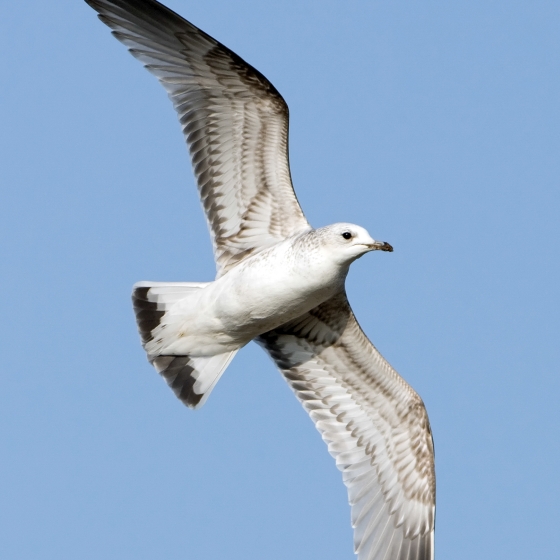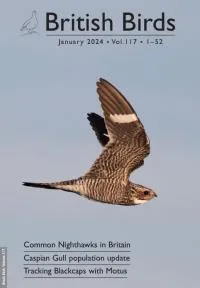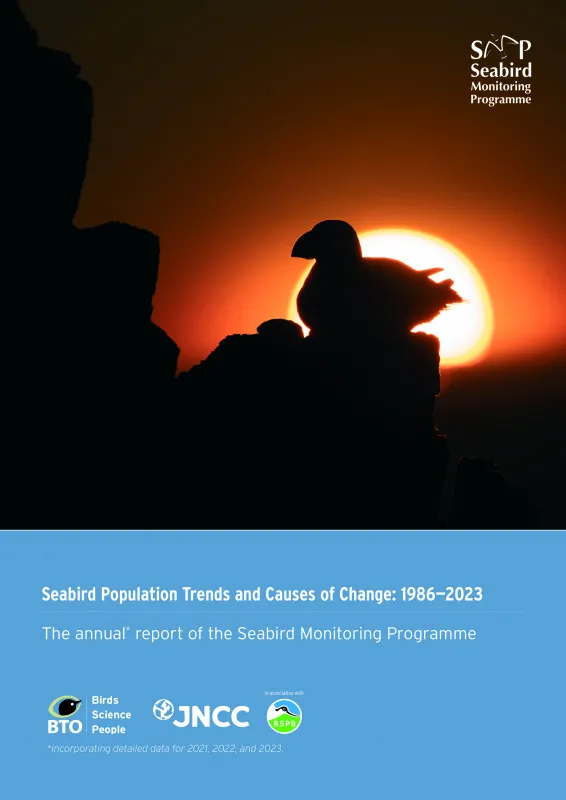Common Gull

Introduction
The Common Gull is a medium-sized gull, with a dark grey back and upperwings and yellowish-green bill and legs.
This species breeds in the north and west of both Britain and Ireland with a preference for upland areas. The highest densities are found in the eastern half of Scotland, whereas in Ireland it is predominantly a coastal bird.
Our breeding population is swelled in winter by the autumn arrival of a large influx from the Continent. Individuals become very widely distributed across the country – though avoiding the uplands – and are most abundant down the eastern half of Britain at this time.

Key Stats
Identification
ID Videos
This section features BTO training videos headlining this species, or featuring it as a potential confusion species.
Common Gull & Herring Gull
Songs and Calls
Call:
Alarm call:
Flight call:
Status and Trends
Conservation Status
Population Change
The coastal-nesting population increased by 70% between the 1969–70 Census and Seabird 2000 (1998–2002). However, more than half of the population counted by Seabird 2000 were breeding inland. The inland breeding colonies have not been counted consistently and hence the overall trend for this species is highly uncertain. The counts made since Seabird 2000 suggest that substantial declines may have occurred at both coastal and inland colonies, although coverage is incomplete and the extent of the decline will not be known until the results of the recent Seabirds Count (2015–2021) are available (JNCC 2022).
Distribution
Each autumn and winter a large influx of continental Common Gulls supplements local breeders, resulting in a very wide winter distribution in Britain, with birds being absent only from upland areas; in Ireland they are mostly coastal. Breeding Common Gulls are found mostly in the north and west of both Scotland and Ireland. However, in Scotland, the highest densities are found on the eastern half of the country from Angus to the Moray Firth, Caithness and the Northern Isles as well as in many Highland straths and glens.
Occupied 10-km squares in UK
or view it on Bird Atlas Mapstore.
or view it on Bird Atlas Mapstore.
European Distribution Map
Distribution Change
The breeding change map highlights recent losses in many parts of Scotland and western Ireland.
Change in occupied 10-km squares in the UK
or view it on Bird Atlas Mapstore.
or view it on Bird Atlas Mapstore.
Seasonality
Common Gulls are recorded throughout the year.
Weekly pattern of occurrence
The graph shows when the species is present in the UK, with taller bars indicating a higher likelihood of encountering the species in appropriate regions and habitats.

Movement
Britain & Ireland movement
Foreign locations of birds ringed or recovered in Britain & Ireland
Dots show the foreign destinations of birds ringed in Britain & Ireland, and the origins of birds ringed overseas that were subsequently recaptured, resighted or found dead in Britain & Ireland. Dot colours indicate the time of year that the species was present at the location.
- Winter (Nov-Feb)
- Spring (Mar-Apr)
- Summer (May-Jul)
- Autumn (Aug-Oct)

European movements
EuroBirdPortal uses birdwatcher's records, such as those logged in BirdTrack to map the flows of birds as they arrive and depart Europe. See maps for this species here.
The Eurasian-African Migration Atlas shows movements of individual birds ringed or recovered in Europe. See maps for this species here.
Biology
Productivity and Nesting
Nesting timing
Egg measurements
Clutch Size
Survival and Longevity
Survival is shown as the proportion of birds surviving from one year to the next and is derived from bird ringing data. It can also be used to estimate how long birds typically live.
View number ringed each year in the Online Ringing Report.
lifespan
Survival of adults
Survival of juveniles
Biometrics
Wing length and body weights are from live birds (source).
Wing length
Body weight
Ring Size
Classification, names and codes
Classification and Codes
- Order: Charadriiformes
- Family: Laridae
- Scientific name: Larus canus
- Authority: Linnaeus, 1758
- BTO 2-letter code: CM
- BTO 5-letter code: COMGU
- Euring code number: 5900
Alternate species names
- Catalan: gavina cendrosa
- Czech: racek bourní
- Danish: Stormmåge
- Dutch: Stormmeeuw
- Estonian: kalakajakas
- Finnish: kalalokki
- French: Goéland cendré
- Gaelic: Faoileag-bheag-an-sgadain
- German: Sturmmöwe
- Hungarian: viharsirály
- Icelandic: Stormmáfur
- Irish: Faoileán Bán
- Italian: Gavina
- Latvian: (kajaks), kaija
- Lithuanian: paprastasis kiras
- Norwegian: Fiskemåke
- Polish: mewa siwa
- Portuguese: famego
- Slovak: cajka sivá
- Slovenian: sivi galeb
- Spanish: Gaviota cana
- Swedish: fiskmås
- Welsh: Gwylan Gweunydd
- English folkname(s): Cob
Research
Causes of Change and Solutions
Causes of change
The causes of change in the Common Gull population are not known. Some studies have shown that American Mink Neovison vison can have a substantial negative effect at a local level and can cause colony abandonment (Craik 1997), but it is unclear whether predation from Mink and other predators may have driven wider population declines.
Publications (3)
The status of the UK’s breeding seabirds
Author: Stanbury, A.J., Burns, F., Aebischer, N.J., Baker, H., Balmer, D., Brown, A.F., Dunn, T., Lindley, P., Murphy, M., Noble, D.G., Owens, R. & Quinn, L.
Published: 2024
Five seabird species are added to the Birds of Conservation Concern Red List in this addendum to the 2021 update, bringing the total number of Red-listed seabird species to 10, up from six since seabirds were last assessed. The Amber List of seabirds moves from 19 to 14 species, and the Green List increases from one to two species.
29.09.24
Papers

Seabird Population Trends and Causes of Change: 1986–2023
Author: Harris, S.J., Baker, H., Balmer, D.E., Bolton, M., Burton, N.H.K., Caulfield, E., Clarke, J.A.E., Dunn, T.E., Evans, T.J., Hereward, H.R.F., Humphreys, E.M., Money, S. and O’Hanlon, N.J.
Published: 2024
This report presents the latest seabird population trends in breeding abundance and productivity using data from the Seabird Monitoring Programme (SMP).The report documents changes in the abundance and productivity of breeding seabird species in Britain and Ireland from 1986 to 2023, and provides a detailed account of the 2021, 2022 and 2023 breeding seasons.This report includes both inland and coastal populations and trends from the Channel Islands, England, Isle of Man, Northern Ireland, Scotland, Wales and the Republic of Ireland, which are presented where sufficient data are available. The results from this report are used more broadly to assess the health of the wider environment, to inform policy and for conservation action.
21.11.24
Reports Research reports

Northern Ireland Seabird Report 2023
Author: Booth, K.J. & El Haddad, H.
Published: 2024
The report includes detailed information about the population trends and breeding success of seabirds in Northern Ireland, over the 2023 breeding season. Notably, Fulmar and Kittiwake populations are reported to be experiencing continued declines, while Guillemot, Common Gull and Herring Gull populations show increases at most breeding sites.
15.04.24
Reports Northern Ireland Seabird Report


